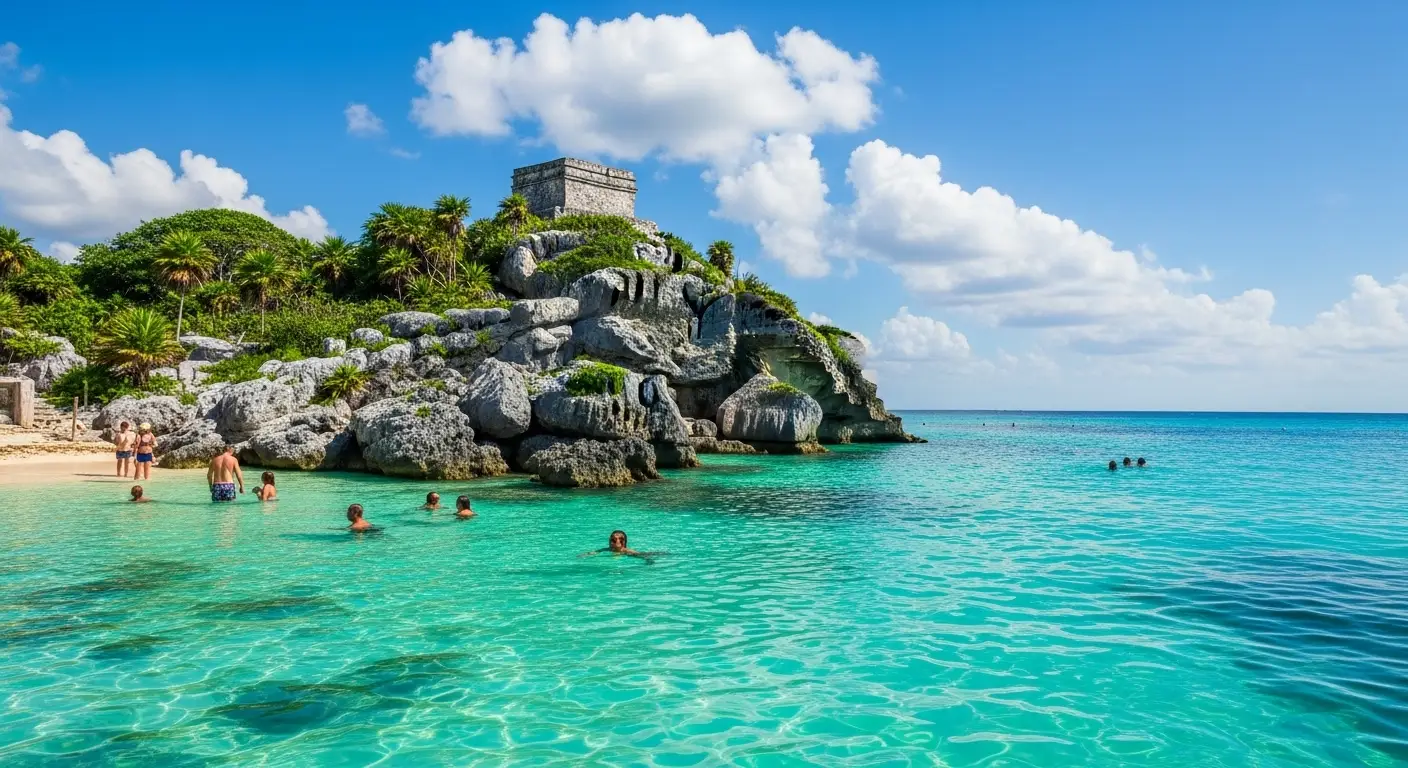You’ve seen those jaw-dropping photos. The turquoise water. The white sand. The swaying palms.
Now you’re standing at a hotel entrance, and someone’s telling you the beach is “for guests only.”
Wait, what?
Here’s something most visitors don’t know: Every beach in Mexico is legally public. Yes, even that one behind the fancy resort.
This guide will show you exactly how to access Tulum’s best beaches without the runaround. No confusion. No wasted time. Just honest information from someone who’s navigated this mess more times than they’d like to admit.
Things have changed big-time in 2025. New access points opened. Rules got clearer. Some got more complicated.
Let’s cut through all that noise.
Public Beaches In Tulum Mexico
The 20-Meter Rule That Changes Everything
Mexican law is clear. All beaches are public up to 20 meters from the high tide line.
No exceptions.
Hotels can’t claim ownership. Beach clubs can’t block access. That exclusive resort? They don’t own the sand.
But here’s the catch—they can control who walks through their property.
That’s where the confusion starts.
Why Some Hotels Still Make Beach Access Difficult
Hotels want to keep their beachfront feeling exclusive. They’ve paid millions for that location.
So they get creative.
Security gates. Vague directions to “public access” that leads nowhere. Staff trained to discourage non-guests.
It’s frustrating as hell.
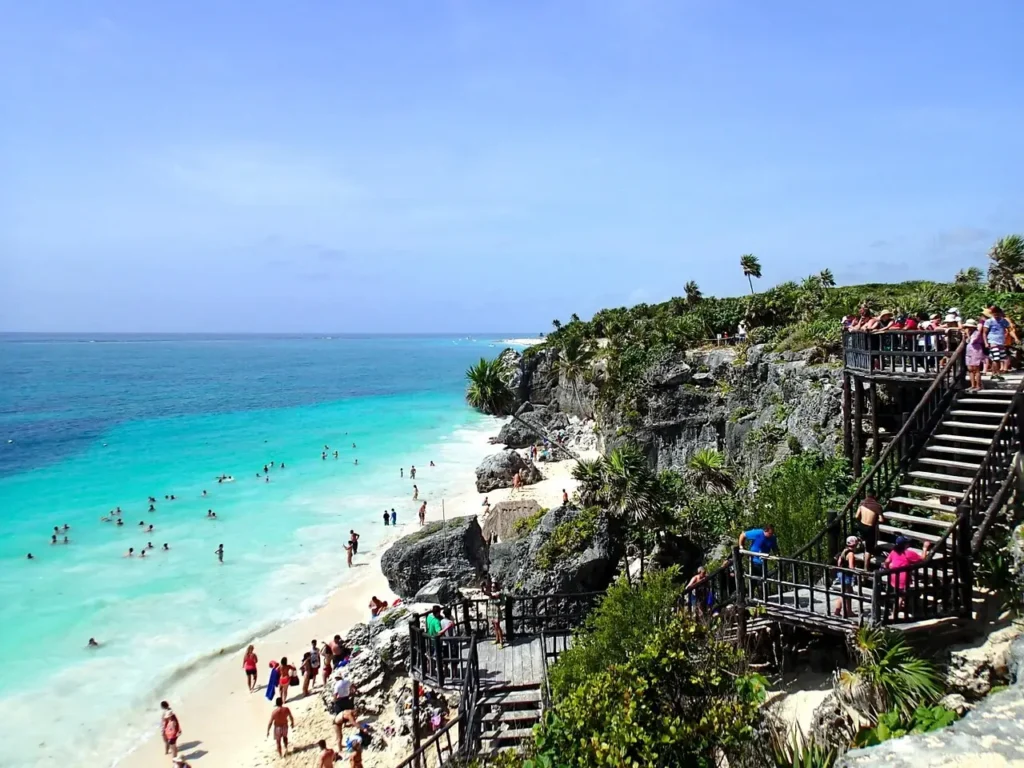
The good news? Tulum has cracked down hard since 2025. Official access points now exist. Enforcement is better.
But you still need to know where to go.
Quick tip: Walk with confidence. Say “public beach access” if anyone questions you. Keep moving. Most issues resolve themselves when you know your rights.
The 5 Best Public Beaches in Tulum Worth Your Time
1. Playa Paraíso – Living Up to Its Name
What Makes This Beach Special
Paraiso means paradise. This beach earned that name honestly.
The sand feels like silk between your toes. The water shifts through every shade of blue imaginable.
It’s stunning. Period.
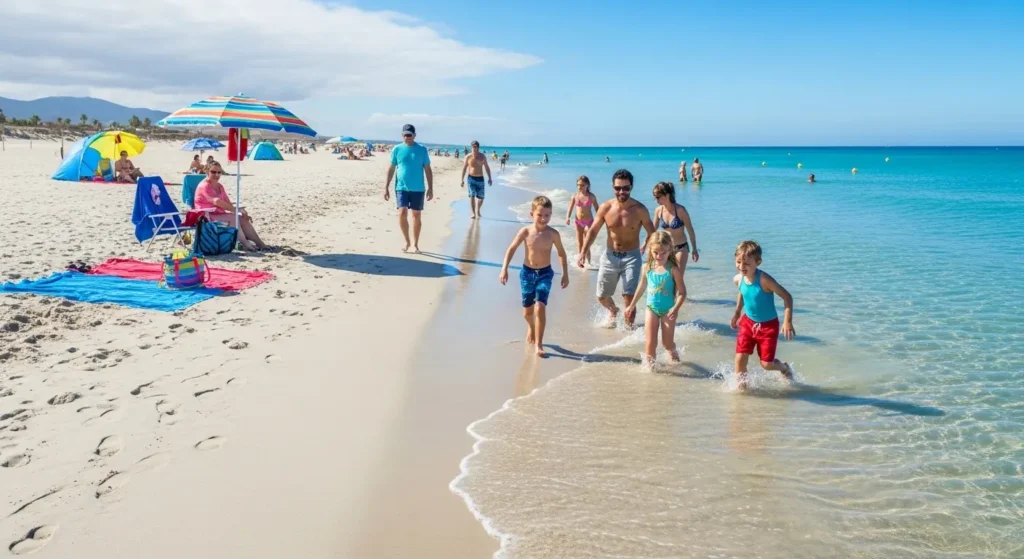
Located north of Playa Paraiso’s main tourist section, this spot delivers natural beauty without the pretense. The gentle slope makes swimming easy for everyone.
This is one of the beach locations where white sand meets perfectly clear Caribbean water.
Palm trees provide shade. The views are Instagram-gold without even trying.
Explore Playa La Ropa beach, Zihuatanejo
How to Get Playa Paraiso Beach
Getting to Playa Paraiso is straightforward once you know the way.
Taxi from downtown Tulum runs 150-200 pesos. Bike rental costs 100-200 pesos per day and takes about 25 minutes.
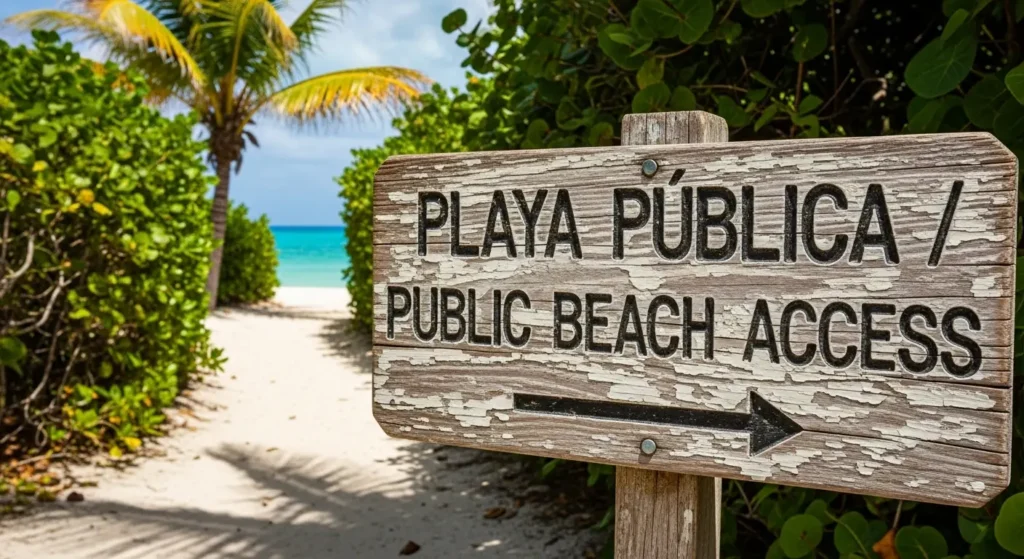
The public access point sits between hotel properties. Look for a sandy path with a small sign.
Most staff recognize this entrance now. Just walk through with your beach gear.
Where to Park (And What It’ll Cost You)
Parking is the tricky part.
A small public parking lot sits 100 meters from the beach entrance. Expect to pay 50-100 pesos per day.
Arrive before 10 AM during high season. Spots fill up fast.
Street parking exists but comes with risks. Theft. Towing. Sun damage to your rental car.
Better to pay the fee and relax.
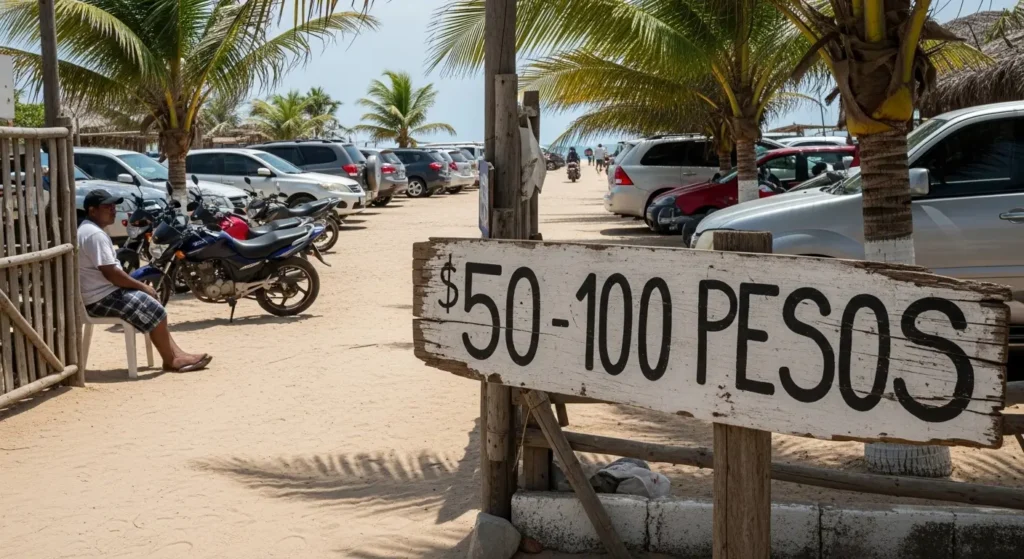
2. Playa Ruinas – Where Ancient History Meets Turquoise Waters
Swimming Below the Mayan Ruins
This is the one beach in Tulum nobody else has.
You’re swimming in crystal-clear water. Looking up at 800-year-old Mayan temples perched on the cliff.
It’s surreal.
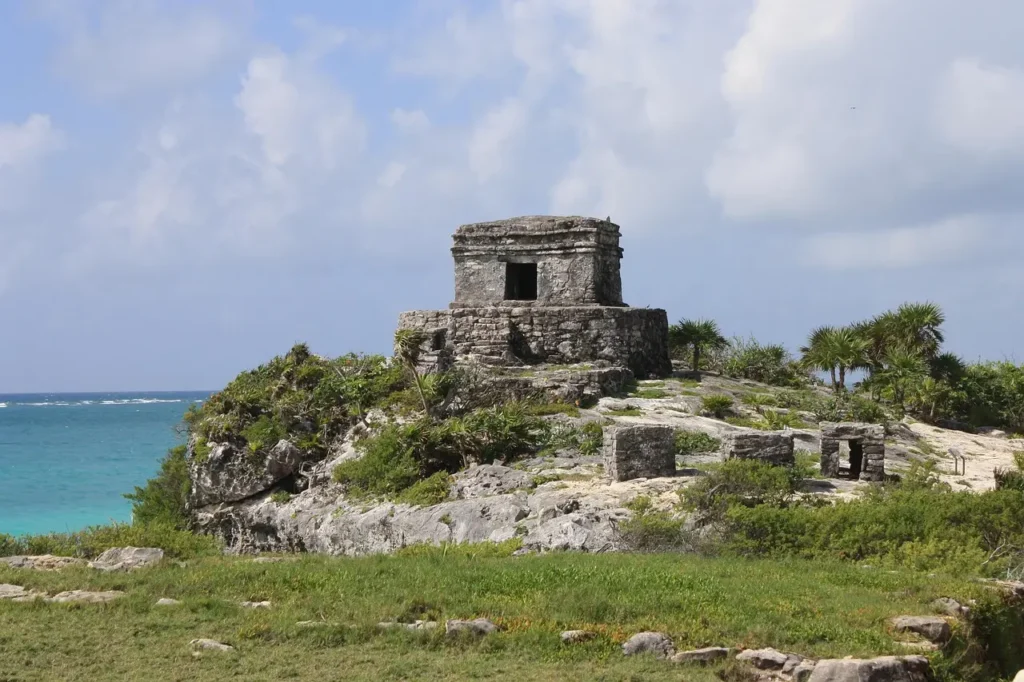
The beach is smaller than others but absolutely gorgeous. Protected location keeps the water calm even when other beaches get choppy.
Perfect for snorkeling near the rocks. Colorful fish everywhere.
Access Through the Archaeological Site
There’s only one way to reach Playa Ruinas.
Pay to enter the Tulum Ruins archaeological site. That’s 515 pesos total for foreign visitors in 2025-2026:
Complete Cost Breakdown:
- CONANP fee: 120 MXN
- Jaguar Park entry: 295 MXN
- Tulum Ruins: 100 MXN
- Total: 515 MXN (~$30 USD)
2026 Price Increase Warning: Starting in 2026, the ruins entrance rises to 210 MXN (from 100), bringing the total to 625 MXN for foreigners.
Mexican nationals pay less: 60 + 195 + 100 = 355 MXN (360 in 2026).
A wooden staircase leads right down to the beach from the ruins. Can’t miss it.
This keeps crowds manageable. Not everyone wants to pay just for beach access.
But you get two experiences in one—explore 800-year-old Mayan temples, then swim in crystal-clear water below them.
Best Time to Visit for Fewer Crowds
Show up at 8 AM when the ruins open.
You’ll have the beach almost to yourself. The morning light is magical for photos.
By noon, tour buses arrive. The beach gets packed.
Late afternoon offers another quiet window. But the site closes at 5 PM, so time it right.
3. Playa Pescadores – The Local Favorite You Haven’t Heard About
Why Fishermen Still Choose This Spot
Pescadores gets its name from the fishermen who’ve launched boats here for generations.
You’ll see colorful fishing boats pulled up on the sand. Men mending nets in the shade.
It’s real Tulum. Not the resort version.
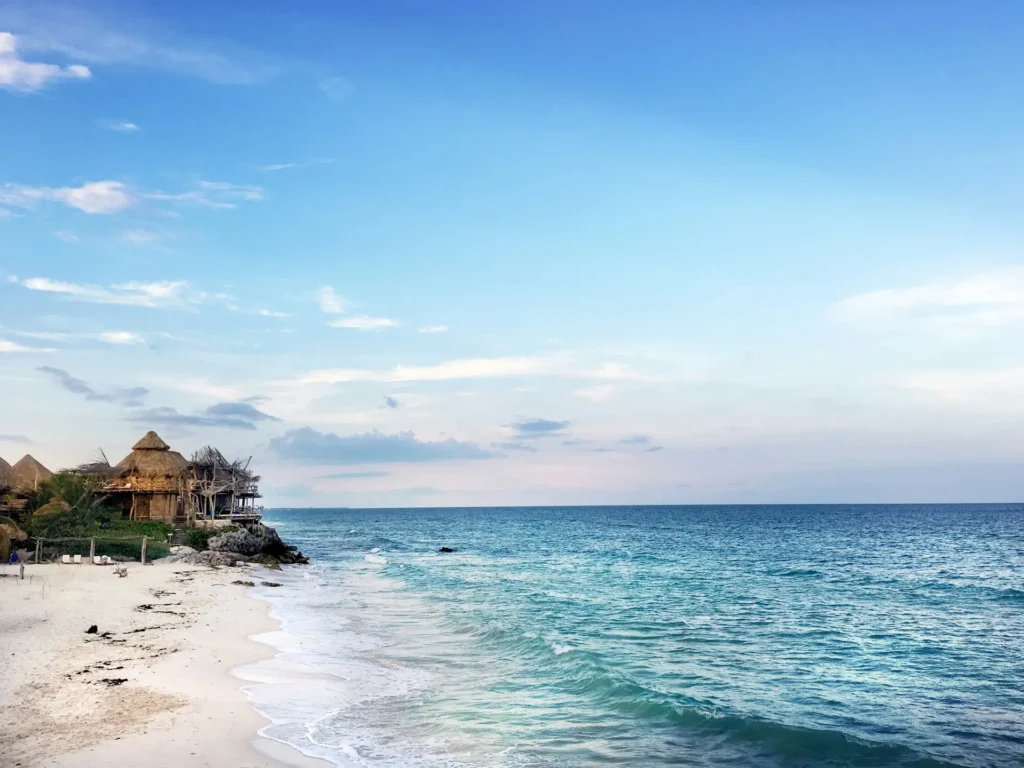
The beach offers great swimming conditions without the crowds. Gentle waves. Decent space.
No fancy amenities. That’s exactly the point.
Finding the Hidden Access Path
The entrance sits south of the main restaurant strip.
Look for a narrow sandy path between two buildings. A weathered “Playa Pescadores” sign marks it.
Not gated. Locals use it freely all day.
Most tourists miss this one entirely. Keeps it peaceful even during peak season.
What to Expect: Amenities and Atmosphere
Don’t expect luxury here.
Basic restrooms in nearby restaurants. No lounge chairs or umbrellas for rent.
Bring your own towel. Your own umbrella. Pack food and drinks from town.
The vibe is laid-back. Families having picnics. Kids playing in the waves.
It’s one of those places that feels like a secret, even though it isn’t.

Local secret: Chat with the fishermen early morning. Many offer informal snorkel trips at way better prices than tour companies charge.
4. Las Palmas Beach – Space to Breathe
The Wider Shoreline Advantage
Las Palmas has something rare in Tulum—space.
The beach stretches wider here. Even on busy days, you’re not crammed next to strangers.
Room for kids to run. Space for beach games. Actual personal space.
The water is perfect for swimming. Gradual depth. Safe for families with children.
Sand quality matches Paraiso’s soft texture.
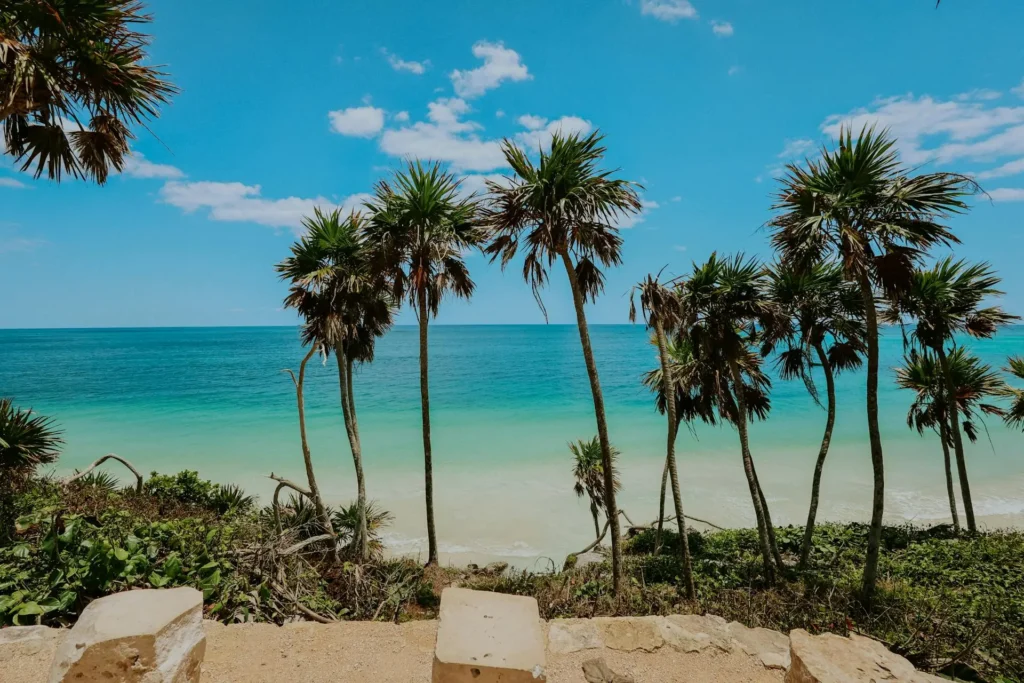
Getting Beach Access in the Hotel Zone
Las Palmas sits right in the hotel zone.
Used to be hard to access. Not anymore.
The main access point now runs through the “Town Beach Access” entrance. Located between two hotels with clear signage.
Feels official. No awkward interactions with security.
The pathway leads directly to the beach entrance, bypassing hotel facilities completely.
Family-Friendly Features That Matter
Parents love Las Palmas for good reasons.
Safe swimming conditions. Wide beach for active kids. Gentle waves.
Nearby restaurants have kid-friendly menus. The atmosphere stays relaxed, not party-focused.
For families planning a trip to Tulum, this beach often wins.
5. Playa Santa Fe – Quiet Mornings and Gentle Waves
Inside Tulum Jaguar Park: What You Need to Know
Playa Santa Fe sits within Tulum Jaguar Park boundaries.

The park was created in 2024 to protect the coastal ecosystem. Especially turtle nesting areas.
This means navigating entry fees. But it also means better maintenance. Cleaner facilities. More environmental protection.
The biosphere designation helps protect sensitive habitats while still allowing tourism.
There’s a trade-off between convenience and conservation.
Free vs. Paid Entry Points (Updated November 2025)
Here’s the deal as of November 2025. This changed EVERYTHING for budget travelers.
Two completely free access points now exist. No fees for anyone—foreign or Mexican visitors.
The main gate charges the fees listed above. But here’s what you need to know:
| Entry Type | Cost | Parking | Facilities | Best For |
|---|---|---|---|---|
| Main Paid Entrance | 415 MXN (foreigners) | 160 MXN (included) | Full amenities | Full-day visits, families |
| Free North Entrance | FREE | Street only | None | Quick visits, budget travel |
| Free South Entrance | FREE | Street only | None | Beach lovers, backpackers |
The free entrances lack amenities—no bathrooms, no showers, no official parking. You’re on your own.
The paid entrance includes everything: clean restrooms, outdoor showers, secure parking, electric shuttles between beaches, and even bike rentals (150 MXN extra).
For budget-conscious travelers, the free access makes perfect sense for short visits.
Families with kids often find the paid entrance worth every peso for the convenience and peace of mind.
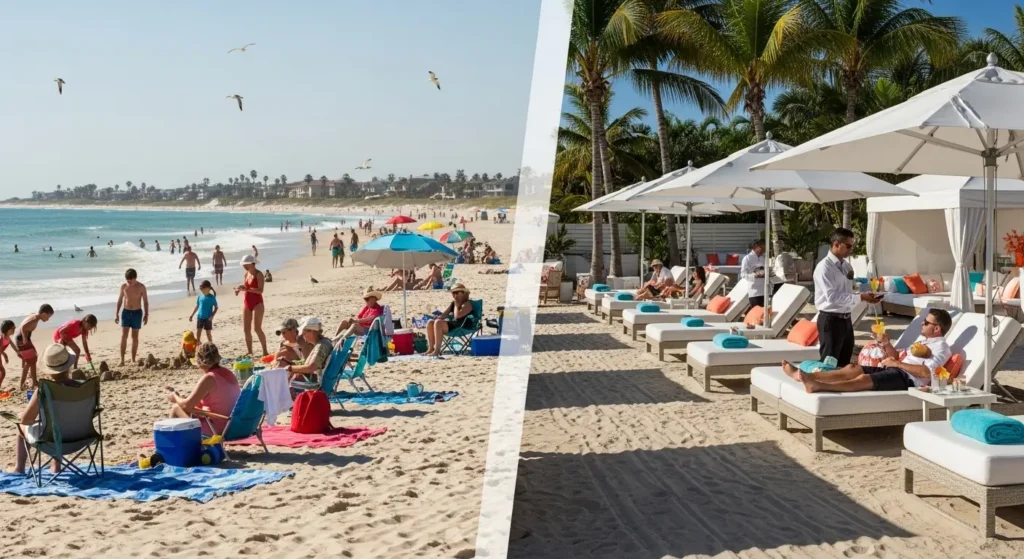
Why Families Keep Coming Back
Playa Santa Fe has a reputation as the family beach.
Consistently calm water. Waves that thrill kids without scaring parents.
Protected location within the biosphere means better environmental care. Cleaner beaches.
Real restroom facilities make a huge difference with young children.
Many families consider the entry fee worthwhile for the peace of mind.
Money-saving tip: Visit on weekdays. Weekends get slammed with both tourists and locals. Facilities get overwhelmed.
Navigating Tulum Jaguar Park in 2026
The Entry Fee Breakdown (Who Pays What)
Let’s break down the costs clearly. Tulum Jaguar Park now requires three separate fees to enter:
Current 2025-2026 Pricing:
| Visitor Type | CONANP Fee | Jaguar Park Fee | Total Cost |
|---|---|---|---|
| Foreign Visitors | 120 MXN | 295 MXN | 415 MXN ($24 USD) |
| Mexican Nationals | 60 MXN | 195 MXN | 255 MXN |
| Quintana Roo Residents | 60 MXN | 45 MXN | 105 MXN |
| Tulum Residents | 60 MXN | Free | 60 MXN |
These fees fund environmental protection, turtle nesting programs, beach maintenance, and park facilities.
Important: If you also want to visit the Tulum Ruins inside the park, add an additional 100 MXN (rising to 210 MXN in 2026 for foreigners).
Two Free Entrance Points Most Tourists Miss
Here’s the game-changer: Two free access points exist where EVERYONE enters without fees.
Free Entrance Locations:
- Northern Access Point – Near the main beach road intersection
- GPS: Centro de Atención a Visitantes (CATVI)
- Street parking only (no facilities)
- Direct beach access
- Southern Access Point – Closer to Playa Santa Fe
- Access via sandy pathway
- No restrooms, showers, or parking
- Less crowded than main entrance
What You DON’T Get at Free Entrances:
- No parking facilities
- No restrooms or showers
- No lifeguards
- No electric shuttle service
Pro tip: The free entrances work great for quick 2-3 hour beach visits. Arrive with everything you need already packed.
What the 415 MXN Actually Gets You
The paid main entrance includes facilities that free access points don’t offer:
Included Amenities:
- ✅ Clean, maintained restrooms and outdoor showers throughout the park
- ✅ Secure designated parking lots (160 MXN, included)
- ✅ Free electric shuttle bus connecting beaches and ruins
- ✅ Lifeguards patrolling during peak hours
- ✅ Access to observation towers and jungle trails
- ✅ 2-kilometer bike path (bike rental: 150 MXN/day)
- ✅ Museum visit (Museo de la Costa Oriental)
- ✅ Water refill stations
What Your Fee Supports:
- Turtle nesting site protection
- Beach cleanup programs
- Habitat restoration projects
- Archaeological site preservation
For families with kids, older relatives, or anyone planning a full beach day, these amenities often justify the 415 pesos.
When the Park Fee Is Worth It (And When It’s Not)
Pay the 415 MXN entrance fee when:
- Planning a full beach day (6+ hours)
- Traveling with young children who need facilities
- Want to visit both beaches AND Tulum Ruins
- Value environmental conservation efforts
- Need secure parking for rental car
- Prefer having restrooms and showers available
Use the FREE entrances when:
- Quick 2-3 hour beach visit
- Tight budget (save $24 USD per person)
- Comfortable with basic beach camping setup
- Visiting multiple beaches in one day
- Don’t need amenities
Money-Saving Strategy: Visit free beaches like Paraiso and Pescadores (outside the park) during your trip, then splurge on ONE day inside Jaguar Park to see Tulum Ruins and Santa Fe Beach together.
How to Access the Beach for Free (Legally)
Walking Through Beach Clubs: What Actually Works
Walking through beach clubs to reach public beach areas sometimes works.
Success depends on timing and confidence.
Arrive during busy periods when staff are distracted. Walk purposefully with beach gear.
But honestly? This approach has become less reliable.
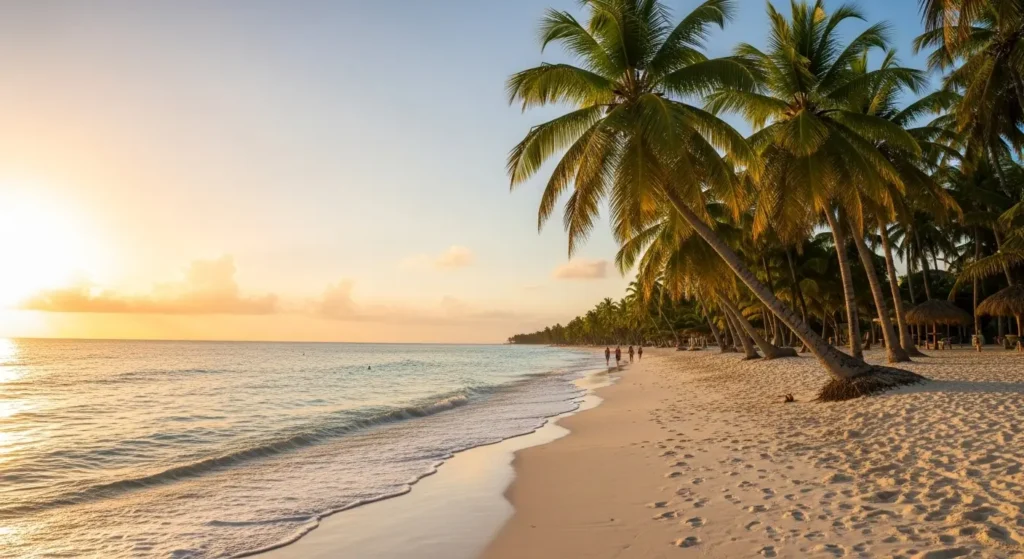
Many beach clubs now station staff specifically to intercept non-customers.
The easier approach: Order a single drink. That costs 200-400 pesos and grants legitimate access through the property.
Way less stressful.
The “Town Beach Access” and “Conchitas Beach” Entry Points
These two official entrances opened in 2025 after sustained advocacy.
Town Beach Access sits in the northern beach section. Direct pathway through what was previously hotel-controlled territory.
Signage clearly marks it as public right-of-way.
Conchitas Beach access is further south. Same straightforward entry.
Both have basic parking nearby. No facilities, but they eliminate the awkwardness of navigating hotel properties.
Best Public Access Paths by Zone
Northern section: Use Town Beach Access or the established Playa Paraiso entry point. These north Tulum beaches generally welcome visitors more openly.
For Pescadores: The marked path between restaurants on the northern beach strip.
Las Palmas: The designated public pathway between hotels in the main hotel zone.
Southern beaches: Either Jaguar Park entrances or the free access points work well.
For beaches outside of Tulum, Xpu Ha Beach offers simpler access with a dedicated public parking lot and clear beach entrance markers.
What You Can (and Can’t) Bring Through Hotel Corridors
When walking through hotel properties, keep it simple.
Fine: Beach towels, small coolers, umbrellas, basic beach toys.
Not fine: Large equipment, speakers, outside alcohol, party supplies.
The key is discretion and respect.
Walk directly to the beach. Don’t stop to use hotel facilities. Don’t linger in hotel-only areas.
This respects property rights while exercising your legal right to public access.
Important: If hotel staff challenge you, calmly reference Mexican beach law. Keep walking toward the beach. Don’t get confrontational, but don’t be intimidated either.
Dealing With the Seaweed Situation
When Sargassum Season Hits Hardest
Let’s talk about the elephant in the room. Or rather, the seaweed on the beach.
Sargassum peaks from April through August. May and June are the worst.
This floating brown algae washes ashore in massive quantities. Creates unpleasant swimming conditions. Smells bad when rotting.

It’s a natural phenomenon intensified by climate change.
Not harmful to humans. Actually plays an important role in ocean ecosystems.
But yeah, it’s not pretty.
The seaweed problem affects most Caribbean beaches. Tulum isn’t unique, but its beaches face significant seasonal buildup.
Which Beaches Handle It Better
Northern beaches like Paraiso and Las Palmas typically get less sargassum.
Favorable currents help. Beach orientation matters.
These spots also get more active cleanup from nearby hotels and beach clubs.
Southern beaches face heavier buildup during peak season. Though Jaguar Park has improved cleanup schedules significantly.
Real Talk: Is It Still Worth Going?
Even during seaweed season, Tulum remains beautiful.
The seaweed typically piles along the shoreline. Deeper water stays clear for swimming.
Early morning visits find cleaner conditions before daily accumulation builds up.
Many travelers adjust expectations. Focus on cenotes during heavy seaweed periods. Explore Sian Ka’an Biosphere Reserve for pristine nature. Take boat trips to clearer waters offshore.
Things to do in Tulum extend far beyond beaches—ancient ruins, jungle adventures, incredible food scene.
The beaches are still enjoyable. Just different from those perfect photos.
Smart move: Check recent Instagram photos tagged with specific beach names. Or ask hotel staff about current conditions. Things can improve dramatically within 48 hours when wind shifts.
Practical Tips for Your Beach Day
Where to Park Without Getting Scammed
Parking around Tulum beaches ranges from legitimate to sketchy. Know the real prices.
Official Parking Rates (2025-2026):
| Location | Cost | Security Level | Notes |
|---|---|---|---|
| Jaguar Park Main Entrance | 160 MXN/day | High | Included with park entry |
| Public lots near Paraiso | 50-100 MXN | Medium | Arrive before 10 AM |
| Beach club parking | Free with purchase | Medium | Minimum 200-400 MXN spend |
| Street parking | Free (risky) | Low | Theft/towing risk |
Official parking lots near popular beaches outside the park charge 50-150 pesos per day. Location and season affect pricing.
These lots offer security and shade. Worth it for vehicle protection.
Always confirm the price before leaving your car. Write it down. Take a photo of the sign. Avoid inflated charges when you return.
Street parking exists but comes with real risks:
- Vehicle break-ins (common)
- Towing (especially near “No Parking” areas)
- Sun damage to rental cars
- Sand absolutely everywhere
If parking on the street, choose well-traveled areas with other vehicles. Never block driveways or access roads.
What to Pack (Besides Sunscreen and a Towel)
For public beaches without facilities, pack smart:
- Toilet paper (restrooms often lack it)
- Hand sanitizer
- Plenty of water
- Snacks
- Light beach umbrella for shade
- Waterproof bag for electronics
- Reef-safe sunscreen (regular sunscreen damages coral)
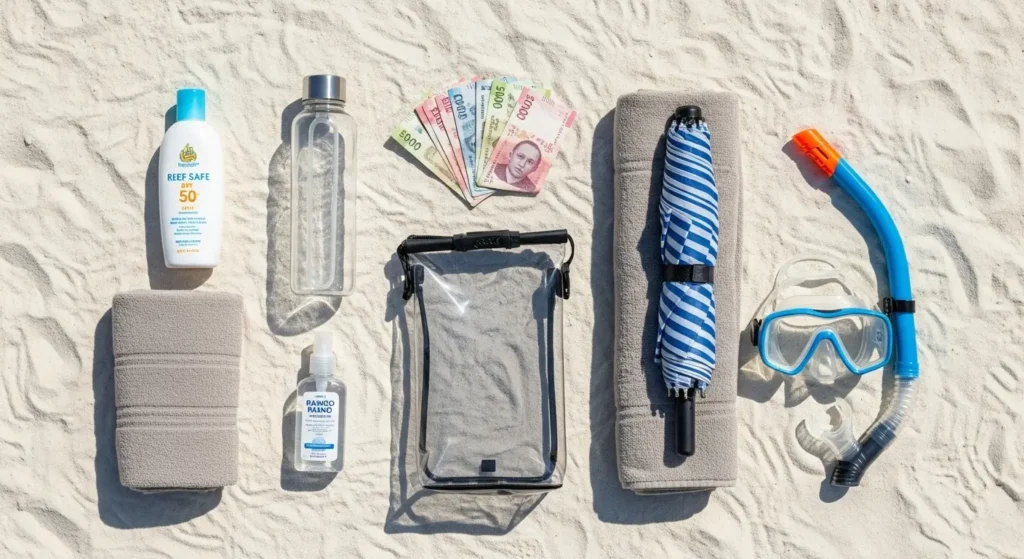
Bring pesos in small bills. Beach vendors don’t take cards. ATMs near beaches often run empty on busy weekends.
The Best Times to Beat the Crowds
Arrive before 10 AM.
You’ll get parking. Better sand selection. Peaceful atmosphere.
Early morning also offers the best light for photos. Cooler temperatures for the bike ride to the beach.
Late afternoon from 3 PM onward sees crowds thin. People head back to hotels. Sunset light is gorgeous.
But services close earlier in off-season. Plan accordingly.
Mobile Payment vs. Cash: What Works Where
Downtown Tulum and major restaurants take cards and mobile payments.
Beach vendors, small parking lots, and taxis? Cash only.
Expect to use pesos for most small transactions at the beach.
ATMs exist in town but are scarce along the beach road.
Withdraw enough cash before heading out. Avoid desperate searches or inflated exchange rates at tourist currency windows.
Pro tip: Keep small bills separate from large ones. Having exact change prevents the classic “can’t make change” excuse from vendors.
Getting to the Beach from Town
Taxi Costs You Should Actually Pay
From downtown Tulum to the beach zone: 150-250 pesos.
Depends on exact destination. Prices jump in the evening and peak season.
Always confirm the price before getting in. Meters are rarely used in Tulum.
Shared colectivos cost 30-50 pesos per person but run on unpredictable schedules.
For groups of three or more, a private taxi often costs the same per person while offering direct service.
Bike Rentals: The Budget-Friendly Option
Renting a bike costs 100-200 pesos per day.
The ride takes 20-30 minutes along the relatively flat beach road.
Many hotels offer free bikes to guests. Makes this option even better.
The bike ride offers unexpected benefits. Stop at scenic viewpoints. Explore side paths. Build an appetite for beachside meals.
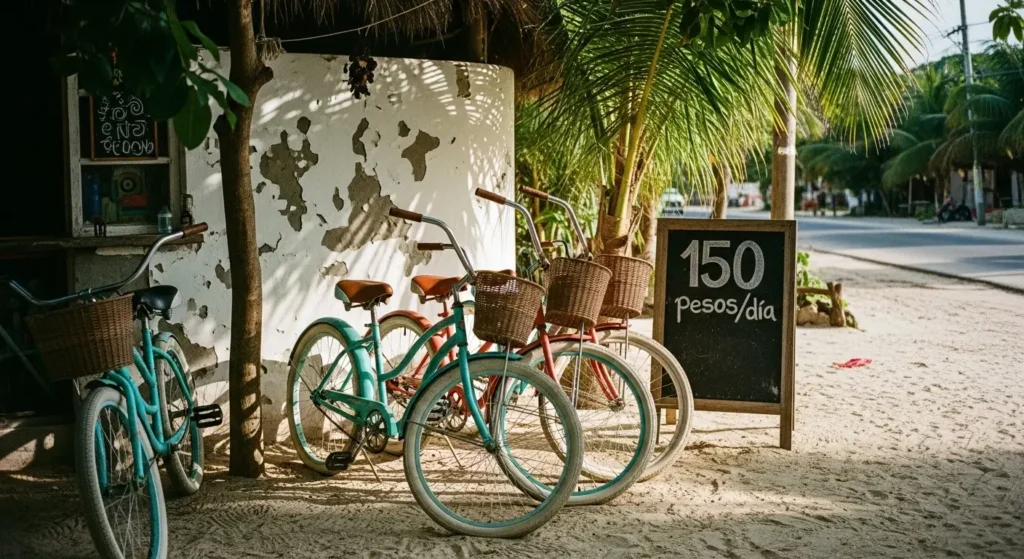
The main road has a bike lane for most of its length. Though watch for potholes and wandering tourists.
Driving Yourself: Road Conditions and Reality Check
The beach road is paved and generally well-maintained.
But speed bumps appear without warning. Drive slowly.
Watch for pedestrians, cyclists, and vehicles that stop suddenly.
Parking is the real challenge. Arrive early or be ready to search.
Rental cars cost 500-1,200 pesos per day depending on vehicle and insurance.
For multi-day stays and exploring beaches near Tulum, visiting the Sian Ka’an Biosphere, or checking out Akumal and Soliman Bay, renting a car provides flexibility taxis can’t match.
Just plan your ride to the beach during off-peak hours to avoid traffic on the narrow beach road.
North Beach vs. South Beach: Which Should You Choose?
The Vibe Difference Nobody Tells You About
The northern beach section feels more accessible and budget-friendly.
Starting from Playa Paraiso and extending to the ruins, public access is easier. Free beaches dominate. The scene feels less exclusive.
This is where many hotels offer simpler access. Less gatekeeping. More authentic Tulum energy.
South of Tulum shifts toward upscale beach clubs and boutique hotels. More curated experience.
These areas attract visitors willing to pay premium prices for everything. Many beach clubs with DJ sets and infinity pools cluster here.
The trade-off is less spontaneity. Higher costs for literally everything from parking to coconuts.
Where to Go Based on What You Want
Choose north Tulum beaches for:
- Budget travel
- Easier access
- Relaxed atmosphere
- Authentic experiences
Paraiso, Pescadores, and Las Palmas deliver natural beauty without pretension.
Select southern beaches for:
- Upscale amenities
- Beach club experiences
- Instagram-perfect settings
- Full-service luxury
The best beach clubs in Tulum cluster here. Full service, DJs, infinity pools, curated vibes.
Worth the minimum spend for some visitors. Not for others.
Strategy: Split your time. Enjoy budget-friendly mornings at northern beaches. Splurge on an afternoon at a southern beach club. Experience both sides.
Beach Clubs Worth the Splurge (If You’re Into That)
When Paying for Access Makes Sense
Beach clubs make sense for special occasions.
Or when you want a full-service experience. Everything provided—no packing, carrying, or planning.
Quality food. Comfortable lounge chairs. Pools. Cocktails. People-watching.

For visitors who’ve explored public beaches and want comparison, spending one beach day at one of the beach clubs provides interesting contrast.
The best tulum beach clubs offer premium experiences—professional DJs, gourmet menus, infinity pools overlooking the Caribbean. Hotels and beach clubs in this category cater to luxury seekers.
Minimum Spend Requirements Explained
Most beach clubs operate on minimum consumption rather than entrance fees.
Expect 600-1,500 pesos per person. Depends on the club and day of week.
This must be spent on food and drinks from their menu. Not refundable.
The minimum spend includes lounge chairs, umbrellas, showers, and restrooms.
Some clubs offer towel service, wifi, and pool access as part of the package.
Understand exactly what’s included before committing. Prevents disappointment with unexpected charges.
Weekend minimum consumption typically runs higher than weekday rates at popular beach clubs in Tulum.
Things Nobody Mentions (But Should)
The Uncomfortable Truth About Beach Access
Enforcement of beach access rules varies based on how visitors look.
International tourists—especially those appearing wealthy or foreign—face less scrutiny accessing beaches through hotels.
Mexican nationals or local families? Different story.
This reflects broader inequality issues within tourism.
The same law protecting everyone’s beach access gets applied inconsistently.
Why Locals Sometimes Get Turned Away
Despite Mexican nationals having explicit legal rights, many hotels train security to discourage local visitors.
They welcome international guests while creating barriers for locals.

The rationale involves maintaining “exclusivity” for paying hotel guests.
But it’s illegal. And deeply problematic.
Mexican families trying to access public beaches through hotel properties face aggressive questioning. Longer delays. Sometimes outright denial.
International visitors rarely experience this.
Being a Respectful Visitor
International visitors can help.
Respect public beach etiquette. Don’t treat beaches as exclusive spaces even when accessing through hotels.
Support businesses that genuinely facilitate public access rather than restricting it.
Small actions matter. Learn basic Spanish. Respect the environment. Don’t leave trash.
Understanding Tulum’s broader context—rapid development, environmental pressures, social tensions—helps visitors make thoughtful choices.
Where to stay. Which businesses to support. How to interact with the place and its people.
Frequently Asked Questions
Are all beaches in Tulum really public?
Yes. Mexican federal law guarantees all beaches are public up to 20 meters from the high tide line. No hotel can legally claim beach ownership, though they can control access through their property.
How much does it cost to visit Tulum beaches?
Public beaches outside Jaguar Park are completely free to access—Paraiso, Pescadores, and Las Palmas cost nothing. Parking may cost 50-150 pesos per day. Tulum Jaguar Park charges foreign visitors 415 pesos (255 for Mexicans) at the main entrance, but offers two completely free access points with no fees for anyone.
Which Tulum beach has the clearest water?
Playa Ruinas typically has the clearest turquoise water due to its protected location below the archaeological ruins. The rocky bottom naturally filters sediment, keeping visibility excellent. Playa Paraiso runs a close second, offering stunning clarity especially during calm weather conditions when sargassum isn’t present.
Can you swim at all Tulum beaches?
Yes, swimming is safe at all major public beach in Tulum. Conditions vary by location and season—Las Palmas and Santa Fe offer the calmest, most family-friendly waters. Always watch for warning flags at beaches with lifeguards, avoid rocky areas when snorkeling, and check with locals about current conditions before entering the water.
Is there seaweed on Tulum beaches right now?
Seaweed conditions change daily based on currents and wind patterns. Check recent Instagram posts tagged with specific beach names (#PlayaParaiso, #TulumBeach) or ask your hotel staff for current conditions. Peak sargassum season runs May through August, with northern beaches like Paraiso typically experiencing less buildup than southern areas.
How do I get to the beach if I’m staying in town?
From downtown Tulum, taxis cost 150-250 pesos one way to the beach zone. Bikes rent for 100-200 pesos per day and take 20-30 minutes to ride. Colectivos (shared vans) charge around 30-50 pesos per person but run on less predictable schedules. Many hotels offer free bike rentals to guests.
Are there public restrooms at Tulum beaches?
Public restrooms are very limited on free beaches outside Jaguar Park. Pescadores and Paraiso have basic facilities at nearby restaurants (usually requiring a small purchase). Paid Jaguar Park entrances include well-maintained restrooms, outdoor showers, and water refill stations throughout the park grounds.
Can I bring my own food and drinks to the beach?
Yes, bringing personal food and drinks to public beaches is completely legal and common practice. Pack everything in reusable containers (no plastic bags in Jaguar Park). Only beach clubs with minimum spend requirements restrict outside food and drinks, and those rules apply only to their facility areas, not the public beach itself.
What’s the best time of year to visit Tulum beaches?
November through March offers the best beach conditions—minimal seaweed, comfortable temperatures (75-85°F), and calm waters perfect for swimming. December and January see peak tourist crowds and higher prices. November and March provide excellent weather with significantly fewer tourists and better accommodation rates.
Is Tulum beach safe for families with kids?
Yes, Tulum beaches are generally very safe for families. Las Palmas and Playa Santa Fe offer the gentlest water conditions with gradual depth and small waves ideal for children. Always supervise kids near water, apply reef-safe sunscreen every 2 hours, stay hydrated in the tropical heat, and visit beaches with lifeguards when possible.
Other Amazing Beaches Worth Mentioning
While this tulum beach guide focuses on the five most accessible public beaches, Tulum’s coastline offers several other stunning spots worth considering.
Soliman Bay sits about 20 minutes north of Tulum. This protected bay offers incredibly calm water perfect for families and snorkeling. Less crowded than popular beaches in Tulum, though it requires a car to reach easily.
Xcacel Beach is a protected turtle nesting sanctuary between Tulum and Playa del Carmen. Limited visitor numbers keep it pristine. The beach entrance requires a small conservation fee. Absolutely worth it for nature lovers who want to support turtle nesting protection efforts.
Akumal Beach is famous for swimming with sea turtles in their natural habitat. Located north of Tulum, this beach attracts snorkelers from around the world. Access is straightforward with a public parking lot and beach entrance clearly marked.
Xpu Ha Beach offers powdery white sand and crystal-clear water. One of the beach locations that feels truly remote despite being accessible. Public access exists, though finding the unmarked entrance between resorts can be tricky.
These beaches near Tulum provide excellent alternatives when the main beaches get too crowded or during seaweed season.
Quick Comparison: Which Beach Is Right for You?
Here’s a simple breakdown to help you choose:
| Beach | Best For | Access Difficulty | Cost | Crowds | Water Quality |
|---|---|---|---|---|---|
| Playa Paraíso | Budget travelers, photos | Easy | Free | High | Excellent |
| Playa Ruinas | History lovers, unique views | Moderate (ruins entry) | 515 MXN total | Medium | Crystal clear |
| Playa Pescadores | Authentic experience, locals | Easy | Free | Low | Very good |
| Las Palmas | Families, space | Easy | Free | Medium | Excellent |
| Playa Santa Fe | Families, facilities | Moderate (park entry) | 415 MXN or free | Medium | Excellent |
Quick Recommendations:
✨ Best for Budget Travelers: Playa Pescadores or Playa Paraiso
Both offer free access, no pressure to buy anything, and authentic Tulum vibes.
👨👩👧👦 Best for Families: Playa Santa Fe or Las Palmas
Gentle waves, wider beaches, better facilities, and safer swimming conditions.
📸 Best for Photos: Playa Ruinas
Ancient temples as your backdrop? Nothing beats it.
🤫 Best for Avoiding Crowds: Playa Pescadores
The hidden access point keeps tourist numbers manageable.
🏆 Best Overall Experience: Playa Paraiso
Lives up to its name with stunning beauty and relatively easy access.
Your list of the best ultimately depends on what matters most—budget, facilities, crowds, or natural beauty.
Final Thoughts: Making the Most of Your Trip
The beaches in Tulum are located along one of Mexico’s most spectacular coastlines.
From Paraiso’s pristine sands to Playa Ruinas’s archaeological beauty. From Pescadores’s local authenticity to Las Palmas’s family-friendly space.
These public beaches deliver unforgettable experiences without luxury resort budgets.
Understanding beach access in 2026—free entry points, Jaguar Park fees, legal rights—empowers confident navigation.
Plan ahead. Know which beaches match your priorities. Approach with excitement and realistic expectations about seasonal variations.
Consider exploring beyond the main five beaches. Soliman Bay, Xcacel, and Akumal each offer unique experiences. The Riviera Maya coastline extends far beyond Tulum proper, with hidden gems waiting for adventurous travelers.
Beyond logistics, visiting these beaches connects you to something larger. The Caribbean’s natural beauty. Mexico’s rich culture. Ongoing conversations about sustainable tourism and equitable access.
Every visitor plays a role in how Tulum’s beach culture evolves.
Pack that towel. Grab pesos for parking. Maybe rent a bike in Tulum for adventure.
Head out and discover which of these five beaches becomes your personal favorite.
The best beach in Tulum depends entirely on what you’re seeking.
The beautiful thing? Finding out requires nothing more than showing up and exploring this amazing beach destination.
